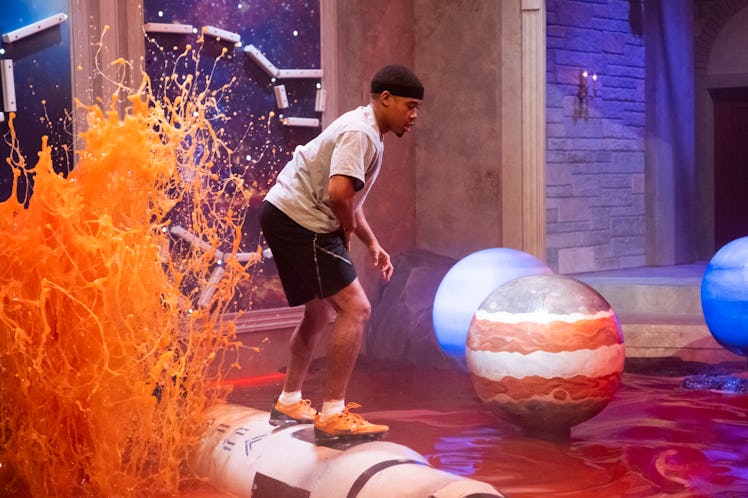
Here’s Everything We Know About How To Apply For Floor Is Lava On Netflix
Time to start practicing your obstacle course skills.
You probably played "the floor is lava" when you were a kid — you know, the game in which you jump across furniture pieces, trying not to touch the floor below you. If so, you might have marathon-watched the first season of Netflix’s hit game show Floor Is Lava while thinking to yourself, "Hey, I could do that." It’s totally understandable — the giant obstacle courses look like a ton of fun, and getting the chance to win $10,000 wouldn't be bad either. If competing in a game show that asks you to leap between objects over a glowing vat of red goo interests you, these details about how to sign up for Netflix's Floor Is Lava might be what you're looking for.
If you haven't watched it yet, Floor Is Lava is quite the ride. In each episode, three teams made up of three contestants each must make their way through an escape room-style course, avoid the lava, and do it all quickly — for a chance to win the cash prize. The contestants chosen for the show are entertaining all on their own, so when you add a melodramatic, high-stakes challenge into the mix, things only get that much more interesting.
The first season, which dropped all 10 episodes on June 19, 2020 — was a hit with fans, and it sat comfortably on Netflix's "Top 10 In The U.S. Today" list within the first week of its premiere. So, it’s no surprise that Floor Is Lava has officially been renewed for a sophomore season, set to hit Netflix in 2022. Unfortunately, if you were hoping to go behind the scenes on Floor Is Lava, it will have to wait for a (hopeful) Season 3. The application for Season 2 closed on June 14, 2021, following the show’s renewal in April. But, given the show’s popularity, it’s highly likely to be renewed for a third season.
So, if you really want to end up on a future episode, it definitely wouldn't hurt to do some prep now to put yourself in the prime position for applying, should that opportunity arise.
How Do You Sign Up For Floor Is Lava?
If the show casts for Season 3 at the same time of year as they did for Season 2, it would likely be around April 2022. To apply, look out for the official application that *could* come from casting boards such as Backstage or Project Casting, two sites that currently post Netflix casting calls.
Before you can sign up for Floor Is Lava, you’ll first need to think about your team. Each team consists of three contestants, ages 18 to 55, who work together to make their way through the themed obstacle course. So, you'll need to find two other people who are semi-athletic and willing to possibly fall into a pit of lava and maybe never be seen again.
After you choose your teammates, it wouldn't hurt for you to come up with a unique backstory to make your group stand out. Season 1 made it clear producers of the show are pretty focused on finding people with interesting stories. For example, there were Episode 3's "mama's boys," three college roommates who now live at home with their mothers. Then there were the "fierce ladies on fire" in Episode 5, who were best friends who wanted the prize money to go on a girl's trip.
How To Prepare For Floor Is Lava
Once you've got your team and story down, it wouldn't hurt to get some physical practice in as well. Why not throw some pillows and chairs down around your house and set up your own lava-type situation? Chances are, your obstacle course won't be as intricate or intense as the one you'd face on the Netflix show, but hey, that's just because Floor Is Lava likely has money to create an entire lava-filled room. Just throw it back to your childhood days by making do with what you've got and using your imagination for the rest.
While waiting for the official application to drop, it probably wouldn't hurt to keep refining your balancing and jumping skills. Happy practicing and good luck!
This article was originally published on